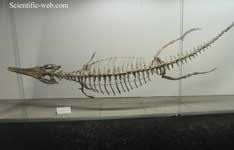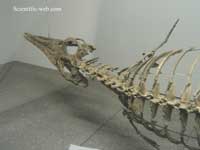

Metriorhynchus jaekeli, Metriorhynchus jaekeli,
| Metriorhynchus Fossil range: 170–150 Ma Bajocian - Tithonian |
||||||||||||||
|---|---|---|---|---|---|---|---|---|---|---|---|---|---|---|
| Scientific classification | ||||||||||||||
|
||||||||||||||
| Species | ||||||||||||||
|
||||||||||||||
| Synonyms | ||||||||||||||
|
Metriorhynchus is an extinct genus of marine crocodyliform that lived in the oceans during the Middle to Late Jurassic. Metriorhynchus was named by the German palaeontologist Christian von Meyer in 1830.[1] Metriorhynchus was a carnivore that spent much, if not all, its life out at sea. No Metriorhynchus eggs or nest have been discovered, so little is known of the reptile's lifecycle, unlike other large marine reptiles of the Mesozoic, such as plesiosaurs or ichthyosaurs which are known to give birth to live young out at sea. Where Metriorhynchus mated, whether on land or at sea, is currently unknown. The name Metriorhynchus means "Moderate snout", and is derived from the Greek Metrio- ("moderate") and -rhynchos ("snout").
Discovery and species
Fossil specimens referrable to Metriorhynchus are known from Middle-Late Jurassic deposits of England, France, Germany,[8] Argentina,[9] and Chile.[5]
Valid species
Species in this genus are traditionally classed into two skull groups: longirostrine (long, narrow jaws) and brevirostrine (short, broad jaws). However there has been some contention as to how many of these species are valid, especially those from the Callovian.
* Eudes-Deslongchamps (1867-69) found there to be four Callovian species: M. superciliosus, M. moreli, M. blainvillei, and M. brachyrhynchus.[10]
* Andrews (1913) considered there to be seven valid species: M. superciliosus, M. moreli, M. brachyrhynchus, M. durobrivensis, M. cultridens, M. leedsi and M. laeve.[4]
* Adams-Tresman (1987) using linear morphometrics however could only distinguish between the two skull groups, so she found there to be two species: M. superciliosus and M. brachyrhynchus.[11]
* Vignaud (1997) however, considered there to be three Callovian species: M. superciliosus, M. brachyrhynchus and M. leedsi.[12]
Longirostrine
* M. superciliosus: Western Europe (England and France) of the Middle-Late Jurassic (Callovian and Oxfordian); M. moreli, M. blainvillei, and M. jaekeli are junior synonyms.
* M. leedsi: Western Europe (England) of the Middle Jurassic (Callovian);[4] M. laeve is a junior synonym.
* M. palpebrosus: Western Europe (England) of the Late Jurassic (Kimmeridgian); M. temporalis is a junior synonym.
* M. hastifer: Western Europe (France) of the Late Jurassic (Kimmeridgian)
* M. acutus: Western Europe (France) of the Late Jurassic (Kimmeridgian) [3]
* M. geoffroyii: (type species) Western Europe (France) of the Late Jurassic (Kimmeridgian) [2]
Brevirostrine
* M. brachyrhynchus: Western Europe (England and France) of the Middle-Late Jurassic (Callovian and Oxfordian); M. cultridens is a junior synonym.
* M. durobrivensis: Western Europe (England and France) of the Middle Jurassic (Callovian). Was originally the type species of the genus Suchodus, but it was regarded as a junior synonym of Metriorhynchus by Andrews, 1913.[4]
* M. casamiquelai: Middle Jurassic of Chile (Callovian);[5]
* M. westermanni: Middle Jurassic of Chile (Callovian). Although previously considered a junior synonym of M. casamiquelai,[13] it has been revalidated; [14]
* M. potens: End Jurassic of Argentina (Tithonian). Was originally the type species of the genus Purranisaurus, but it was regarded as a possible junior synonym of Metriorhynchus by Gasparini.[9]
Unnamed species
Fragmentary remains of Metriorhynchus are known from South America during the Bajocian [13] and Bathonian (both Middle Jurassic).[15]
Taxonomy and phylogeny
The genera Purranisaurus and Suchodus are junior synonyms of Metriorhynchus,[8] Recent phylogenetic analyses however, do not support the monophyly of Metriorhynchus.[16][17][18] Some of the longirostrine forms, however, do appear to form a natural group.[16][18][19]
Palaeobiology
Morphology
Averaging three metres in length, which when compared to living crocodilians, Metriorhynchus can be considered moderate-sized. Its body was streamlined for greater hydrodynamic efficiency, which along with its finned tail made it a more efficient swimmer than modern crocodilian species.[20]
Salt glands
Recent examination of the fossil specimens of Metriorhynchus superciliosus, have shown that adults of this species had well-developed salt glands.[21] This means that like Geosaurus it would have been able to "drink" salt-water (necessary for a pelagic animal) and eat prey that have the same ionic concentration as the surrounding sea water (i.e. cephalopods) without dehydrating.[22]
Diet
Metriorhynchus was a versatile and opportunistic predator, predated upon both the armoured belemnites, fast moving fish and the giant filter feeding fish Leedsichthys. Occasionally it was also capable of capturing flying animals such as the pterosaurs and scavenging on plesiosaur carcasses on the seafloor. [23]
Palaeoecology
Predators
Even though Metriorhynchus was an effective predator, it was vulnerable to predation from apex predators such as Liopleurodon which could grow in excess of 10 metres in length. Since Metriorhynchus had lost its osteoderms, "armour scutes", to become more efficient swimmers it would have had little defence against larger marine predators.
In Popular Culture
Metriorhynchus has featured in the Jurassic episode of the BBC television series Sea Monsters.
* It also starred in Ice Age: The Meltdown as Cretaceous
See also
* List of marine reptiles
References
1. ^ a b Meyer H Von. 1830. Achte Versammlung der Naturforscher und Aerzte zu Heidelberg im September 1829. Isis von Oken, 1830: 517-519.
2. ^ a b Meyer H von 1832. Paleologica zur Geschichte der Erde. Franfurt am Main, 560 pp.
3. ^ a b Lennier G. 1887. Description des fossiles du Cap de la Hève. Bulletin de la Société Géologique de Normandie, Le Harve 12: 17-98.
4. ^ a b c d Andrews CW. 1913. A descriptive catalogue of the marine reptiles of the Oxford Clay, Part Two. London: British Museum (Natural History), 206 pp.
5. ^ a b c Gasparini Z, Chong G. 1977. Metriorhynchus casamiquelai n. sp. (Crocodilia, Thalattosuchia) a marine crocodile from the Jurassic (Callovian) of Chile, South America. Neues Jahrbuch für Geologie und Paläontologie, Abhandlungen 153 (3): 341-360.
6. ^ Gasparini ZB. 1980. Un nuevo cocodrilo marino (Crocodylia, Metriorhynchidae) del Caloviano del norte de Chile. Ameghiniana 17: 97–103.
7. ^ Rusconi C. 1948. Nuevo plesiosaurio, pez y langostas del mar jurasico de Mendoza. Mendoza, Mus. Hist. Nat., Rev. 2: 3–12.
8. ^ a b Steel R. 1973. Crocodylia. Handbuch der Paläoherpetologie, Teil 16. Stuttgart: Gustav Fischer Verlag,116 pp.
9. ^ a b Gasparini Z. 1975. Revison de ?Purranisaurus potens RUSCONI, 1948 (Crocodilia, Thalattosuchia). Los Thalattosuchia como un nuevo Infraorden de los Crocodilia. Actas del Congreso Geologico Argentino 5: 423–431.
10. ^ Eudes-Deslongchamps E. 1867-1869. Notes Paléontologiques. Caen and Paris: 320-392.
11. ^ Adams-Tresman SM. 1987. The Callovian (Middle Jurassic) marine crocodile Metriorhynchus from Central England. Palaeontology 30 (1): 179-194.
12. ^ Vignaud P. 1997. La morphologie dentaire des Thalattosuchia (Crocodylia, Mesosuchia). Palaeovertebrata 26: 35-59.
13. ^ a b Gasparini Z, Vignaud P, Chong G. 2000. The Jurassic Thalattosuchia (Crocodyliformes) of Chile: a paleobiogeographic approach. Bulletin Société Géologique de France 171 (6): 657-664
14. ^ Gasparini ZB, Paulina-Carabajal A, Chong G. 2008. Un nuevo espécimen de cocodrilo marino del Jurásico Medio del norte de Chile: revalidación de Metriorhynchus westermanni (Crocodyliformes: Metriorhynchidae). Revista Geológica de Chile 35 (2): 335-346.
15. ^ Gasparini Z, Cichowolski M, Lazio DG. 2005. First record of Metriorhynchus (Reptilia: Crocodyliformes) in the Bathonian (Middle Jurassic) of the Eastern Pacific. Journal of Paleontology 79 (4): 801–805.
16. ^ a b Young MT. 2007. The evolution and interrelationships of Metriorhynchidae (Crocodyliformes, Thalattosuchia). Journal of Vertebrate Paleontology 27 (3): 170A.
17. ^ Gasparini Z, Pol D, Spalletti LA. 2006. An unusual marine crocodyliform from the Jurassic-Cretaceous boundary of Patagonia. Science 311: 70-73.
18. ^ a b Wilkinson LE, Young MT, Benton MJ. 2008. A new metriorhynchid crocodilian (Mesoeucrocodylia: Thalattosuchia) from the Kimmeridgian (Upper Jurassic) of Wiltshire, UK. Palaeontology 51 (6): 1307-1333.
19. ^ Mueller-Töwe IJ. 2005. Phylogenetic relationships of the Thalattosuchia. Zitteliana A45: 211–213.
20. ^ Massare JA. 1988. Swimming capabilities of Mesozoic marine reptiles; implications for method of predation. Paleobiology 14 (2):187-205.
21. ^ Gandola R, Buffetaut E, Monaghan N, Dyke G. 2006. Salt glands in the fossil crocodile Metriorhynchus. Journal of Vertebrate Paleontology 26 (4): 1009-1010.
22. ^ Fernández M, Gasparini Z. 2008. Salt glands in the Jurassic metriorhynchid Geosaurus: implications for the evolution of osmoregulation in Mesozoic crocodyliforms. Naturwissenschaften 95: 79-84.
23. ^ Forrest R. 2003. Evidence for scavenging by the marine crocodile Metriorhynchus on the carcass of a plesiosaur. Proceedings of the Geologists’ Association 114: 363-366.
Suggested reading
* Buffetaut E. 1982. Radiation évolutive, paléoécologie et biogéographie des Crocodiliens mésosuchienes. Mémoires Societé Geologique de France 142: 1–88
External links
Retrieved from "http://en.wikipedia.org/"
All text is available under the terms of the GNU Free Documentation License

